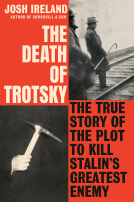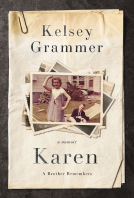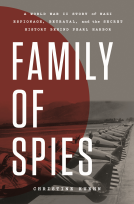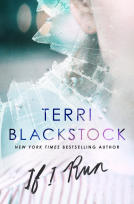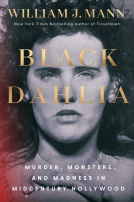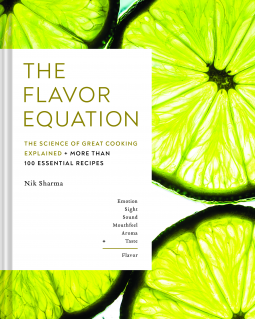
The Flavor Equation
The Science of Great Cooking Explained + More Than 100 Essential Recipes
by Nik Sharma
This title was previously available on NetGalley and is now archived.
Send NetGalley books directly to your Kindle or Kindle app
1
To read on a Kindle or Kindle app, please add kindle@netgalley.com as an approved email address to receive files in your Amazon account. Click here for step-by-step instructions.
2
Also find your Kindle email address within your Amazon account, and enter it here.
Pub Date Oct 27 2020 | Archive Date Oct 26 2020
Talking about this book? Use #TheFlavorEquation #NetGalley. More hashtag tips!
Description
Sorry friends, not available for Kindle download. Also, copyright watermarks throughout.
One of the most anticipated Fall cookbooks by The New York Times, Eater, TheKitchn, Epicurious, Chowhound, and many more.
From the celebrated and award-winning author of Season comes a cookbook that explains the simplest ways to play up any and all of these sensations for the most flavorful food.
Every time you cook, you’re trying to hit just six notes: richness, brightness, depth, heat, saltiness, and sweetness. The Flavor Equation presents an in-depth exploration of the science of taste, with more than 100 illustrations for visual learners.
More than 100 go-to recipes for favorite dishes—curries, one-pot vegetarian mains, soups—for cooks of all skill levels, with a photo of almost every recipe, in Nik Sharma's trademark evocative and moody style. Some recipes include dairy and meat.
Find out how you can enter to win an immersive Flavor Equation experience: https://niksharma.chroniclebooks.com/
A Note From the Publisher
Advance Praise
“I find Nik Sharma’s take on flavor totally fascinating. It is deep and illuminating, fresh and highly informative. That, combined with his always-sumptuous food and staggering photographs, makes The Flavor Equation a most brilliant achievement.” —Yotam Ottolenghi, chef and author of Jerusalem, Plenty, and Simple
“Some consider cooking to be a series of chemical and thermodynamic reactions, others see it as an embodiment of heart, emotion, culture, and family. In The Flavor Equation, Nik Sharma shows us how these elements—the brain and the heart—are not at odds with each other, but that they are in fact intimately intertwined. Understanding their interaction is the key to unlocking flavor in your own cooking, as Nik demonstrates in this beautiful and intelligent book.” —J. Kenji López-Alt, author The Food Lab and Chief Consultant for Serious Eats.com
“Flavor is destined to be classic: original, thought-provoking, and illuminating. It is a book that will change the way you think about food and cooking, and will help to make all your other cookbooks make sense.” —Nigella Lawson , food writer, journalist, and broadcaster
“In The Flavor Equation, Nik marries the art and science of cuisine. It offers a holistic approach to cooking at home; one that celebrates both chemistry and emotion, in both the creation and enjoyment of our meals.” —Stella Park, pastry chef and author of BraveTart: Iconic American Desserts
“If you’re interested in flavor—and every cook is, that’s what we constantly think about—this book is for you. I haven’t learned so much from a single book in a very long time. I'm now cooking my way through it. "—Diana Henry, James Beard award-winning author of A Bird in the Hand
“Nik Sharma answers the hows and whys of taste from a scientific perspective as well as one from a well-seasoned cook. The multicultural flavors that are sure to entice anyone's taste buds to spring into action. Anyone wanting to take a deep dive into how to make food taste better will revel in Nik's thoroughly researched—and gorgeously photographed—treatise on the topic.” —David Lebovitz, author, My Paris Kitchen and Drinking French
Marketing Plan
Pre-Order Campaign with exclusive downloadable content (8 bonus recipes)
Social Media Giveaway of kitchen products including Staub, California Olive Ranch olive oils, and Spiceology spices.
Limited Pre-Publication Giveaways of Print Book on Goodreads
Signed Pre-Order Books at participating independent booksellers
Bookshop.org affiliate link proceeds support Feeding America
Available Editions
| EDITION | Hardcover |
| ISBN | 9781452182698 |
| PRICE | $35.00 (USD) |
Average rating from 36 members
Featured Reviews
 Alyssa M, Reviewer
Alyssa M, Reviewer
I received a copy of this book from NetGalley in exchange for an honest review.
This was a surprisingly thorough read!
Sharma explores all the things that go into a taste - from flavor to mouthfeel there's a whole equation on how to make an enjoyable meal.
From this equation the book is broken down into each piece of the equation. From helpful infographics to very specific details about which ratios of fat to oil go together and what flavors meld this book is surprisingly scientific.
There are also recipes. The photos that are in this book are beautiful - I wish there were more of them for each recipe. Sharma explains how the flavors and textures work together and how to use acids and dairies and other common ingredients before sharing recipes that bring them all together.
There is also a helpful kitchen staples section, although it is at the back of the book which I didn't expect. Overall this is an unexpectedly thorough and fact-based approach to cooking that is very educational!
 Nicole A, Reviewer
Nicole A, Reviewer
A comprehensive book about all of the science behind flavor. How emotion and the flavor of our food impact memories of special times in our lives, how recipes trigger moments of recollection of days gone by and how it effects the slightest craving as we catch an aroma. How our senses process what we eat before the food rests on our tongue. Sharma delves into the flavors of colors and shapes and how sounds can make certain foods enticing to us. With charts and graphs and diagrams the science of flavor and how and why we eat come alive along with colorful, bold photos throughout. If you are interested in why we love food from a scientific standpoint this book is for you!
 Reviewer 186721
Reviewer 186721
This book is endless with so much knowledge in culinary science and many other science departments. Reminds me of the engineer who made sous vide famous. At the same time it is accessible to. Explains the sequence of the ingredients and how the process is changed with time and treatment. Deep primer into the cooking kingdom.
 Evalina I, Reviewer
Evalina I, Reviewer
The appreciation of a flavor is something that may vary from person to person. In this book, the author looks at the various components which make up the concept of flavor—what has been termed the Flavor Equation. The Flavor Equation explores the “anatomy of flavor” and utilizes “flavor maps and pyramids” to demonstrate how a combination of these components will result in unique taste experiences. These taste experiences, in turn, guide the person’s response to the foods eaten. These responses determine whether or not a recipe will be considered delicious.
Each component is discussed by the author with the goal of providing the reader with clarity as to the component’s involvement in flavor. Then, various cultural recipes from India are provided where the author shares the link between the recipes and the flavor equation components. However, while the recipes are from the Indian culture, the concepts presented are transferable to any other culture.
I really liked this book. As a person involved in counseling clients regarding their food choices, I am often asked if the changes recommended will “taste good”. A book like this is helpful in understanding the various components involved in how food tastes. This will provide greater assistance in helping clients understand what they may do to increase food acceptance aka deliciousness. The author does get really involved in explaining the technical parts, so I am not sure that everyone will understand it. However, depending on the reader, the concepts can be understood, simplified, and demonstrated via the recipes.
I definitely would purchase this book for personal use as well as for a gift. It is also a book that could be considered for use in a culinary arts or nutrition class.
I voluntarily reviewed an Advanced Reader Copy of this book provided by the publisher and Net Galley. However, the thoughts expressed are totally my own.
My first book on the science of flavour and I learned so much! I loved the tips on how to take your food to the next level by boosting flavours. I took so many notes! The graphics and photographs are beautiful too.
The recipes are arranged rather unconventionally - by taste (saltiness, savoriness etc) rather than type or meal. But there are meal ideas at the back of the book.
The recipes look very interesting and delicious. Unfortunately, I am on a therapeutic low carb diet so many of them do not suit me. I also prefer ingredients that are already in my pantry, being a lazy cook.
Those who don't mind doing a little bit of hunting in their Asian stores (and are not on a low carb diet) will find this book really useful and worthwhile.
Thank you Netgalley and Chronicle Books for the ARC. This is my honest opinion.
 Dannielle F, Reviewer
Dannielle F, Reviewer
This was a very thorough read, and I appreciated the way that the author explains what elements make a recipe taste good and how different elements can effect your eating experience. The recipes provided are interesting and I will definitely be making them in the future.
This book is simply wonderful. I always like to try the recipes in any book I review and I started with a couple which proved to be both easy to make and bursting with flavour.
I then delved further into the book to discover Nik's research into what makes the best dishes we've eaten so memorable: How emotion, sight, sound, mouthfeel , aroma and taste all contribute to flavour. You feel that you are in such good, friendly, encouraging hands.
This is definitely a book I want on my shelf, so I can continue to understand and create delicious dishes.
 Media/Journalist 16509
Media/Journalist 16509
This is a great book on the science of flavor and cooking. I love the technical aspects of it and how much Sharma goes into the reason behind every technique and ingredient. He provides lots of recipes to illustrate the teachings, and beautiful photos and fascinating charts are used throughout. I have to admit that the recipes didn't really appeal to me that much. They are all Indian recipes, which I love on occasion but not 24/7. I would have loved to see more diversity in flavors from all over. That said, it's brilliant and really helps you understand how to make things work in the kitchen.
I read a temporary digital ARC of this book for review.
**I received an e-ARC from NetGalley for an honest review**
I tried several of the recipes, and the "Hot Honeycomb Candy", "Shaved Brussels Sprouts Salad", and "Hasselback Potatoes with Pancetta + Pumpkin Seed Chutney" will all be on rotation in my kitchen. The "Peppermint Marshmallows" will probably be a dish I limit to the holiday season, but they were delicious and something I had never tried to make before.
Unfortunately, due to the pandemic and limited supplies, I couldn't make some of the recipes as written and had to do a couple of substitutions, but even then, those recipes were amazing. I definitely plant to try and re-do those recipes as written as soon as possible!
Overall, while I loved this cookbook, it's not a cookbook I would recommend to anyone who doesn't love to cook and love to eat. A lot of the ingredients and garnishes felt as if the author was trying to hard to be impressive rather than relying on the recipes themselves to do the work.
Flipping through "The Flavor Equation", I thought of my elementary and secondary science courses trying to find everyday usability amongst all the formulas and elements crammed into our brain for standardized tests. I wish this book existed during my younger years because I'd find tons of ways to use this in my life back then. Although, to be honest, I think I'll probably make this one of my go-to cookbooks when it's officially released. Splitting chapters into flavor profiles - brightness! saltiness! - is honestly genius and I'm surprised I don't see this type of organization done more often. I can't wait to make the pomegranate poppy seed wings and shaved brussels sprouts salad staples in my kitchen, hot dang!
The Flavor Equation is a science-based guide to flavor and sensory experience with accompanying recipes developed by Nik Sharma. Due out 27th Oct 2020 from Chronicle Books, it's 352 pages (print edition) and will be available in hardcover and ebook formats.
Most cookbooks (even niche ones) are arranged thematically: breakfast, lunch, dinner, drinks, etc. Some of them have styling and serving advice in addition. This recipe collection is not at all like the usual cookbook presentation. First, the author spends roughly 16% of the book's content exploring the basis of taste, how we experience taste, mouthfeel, scent, and the roles they play in emotion and perception. There are a lot of interesting takeaways here and while many of them are interesting in their own right, there are also practical bits of information which can be utilized in other non-cooking situations.
The recipes themselves are varied and interesting and represent a number of different world cuisines (some emphasis on the Indian subcontinent). They are arranged thematically: brightness, bitterness, saltiness, sweetness, savoriness, fieriness, and richness. The book is lavishly and appealingly illustrated with large clear recipe and serving photographs. Each of the recipes includes yields, prep and cooking time, ingredients (including metric measurements, yay!), a short description, and step by step instructions. The recipes also include a flavor profile and the reasons for the author's selection of certain ingredients. Nutritional information is not included. The appendices include staples (including spice blends), menu serving suggestions, some info on flavor science (which goes into delightful detail about the molecular components of the food we eat and what they mean for us biologically), a bibliography and links for further information and an index.
This is a wonderfully in-depth book which can also be used on a much less complex basis by simply following the author's suggestions in the recipes. I was impressed on a lot of levels. Definitely one which will appeal to all the bio-nerds, but also to keen cooks looking for more theoretical information for developing and varying their own recipes.
Four stars.
Disclosure: I received an ARC at no cost from the author/publisher for review purposes.
I highly recommend The Flavor Equation by Nik Sharma, an author without a professional chef title but an author with years of cooking experience and a science background. In addition, Sharma has a background as a professional food photographer, which is clear in this book. The photos might be the best part of the book. Whereas some cookbooks spend an inordinate amount of time describing a recipe, The Flavor Equation gives beautiful pictures to show what the food should look like after completing a recipe.
That said, the writing and the recipes don’t disappoint. Sharma gives readers a better understanding of flavor elements, such as brightness and saltiness. In fact, the recipes are divided by different flavor components. I enjoyed Sharma’s candor, such as the fact that his stomach for fieriness pales in comparison to that of his family members. Unlike other cookbooks that offer readers a very basic understanding of flavor elements, Sharma gives a detailed breakdown of the science of flavors. For example, he explains why lemons and limes are used so frequently at the end of a dish to give a pop of acid.
The recipes are excellent. This reviewer just made the Paneer Pulao last night. The dish had a delicate balance of spice and richness with the paneer, but the brightness added by the lime juice at the end of the recipe and the suggestion of yogurt made the recipe more complex and satisfying. There are plenty of other recipes with great balance in a similar vain. There are plenty of recipes that only require basic ingredients, but if you’re willing to visit a local Asian grocery store, you can master all of the recipes and expand your repertoire.
This is a delightful new cookbook that specializes in Indian cooking with some additional twists as well.. The photography is gorgeous and plentiful. They also give a great sense of what the dish should look like once you try to cook it. I adore Indian food but it isn't something that I have had much practice making at home. The explanations given for foods and flavors are descriptive and encouraging to home cooks.
I think my favorite aspect of this book, that is not always seen in cookbooks, is the food science explanation for various aspects of cooking. Why savory versus sweet? How to cook something in a crispy method or a soft method and why choose one or the other? What are different forms of sweet flavor and how do you use or combine them in recipes? How do I combine various key factors in cooking to get the most out of a dish? There is so much here to read and reread. I will most definitely buy this cookbook to add to my collection when it comes out.
Highly recommend.
#TheFlavorEquation #NetGalley #ChronicleBooks
I didn’t recognize Nik Sharma’s name when I requested to review The Flavor Equation: The Science of Great Cooking Explained, but a few minutes of research reminded me that I have enjoyed his cooking blog in the past – A Brown Table. His recipes are thoughtful and creative and his food photography is spectacular. I recommend him as a follow on Instagram and Twitter as well. I received this as an arc from NetGalley in exchange for an honest review.
The Flavor Equation sits in that intersection of food and science, but on a different corner than the gadget and technology cookbooks. To be clear, I love all the cookbooks. The science of this is more Salt Fat Acid Heat than molecular gastronomy. In fact, it would make an excellent companion book to Samin Nosrat’s book. I can’t gauge the accuracy of the science, but it was interesting to read and gave me something to think about.
Sharma approaches food from a love of flavor and a love of chemistry. Flavor is influenced by by some things a recipe cannot account for – genetics, culture, emotion and memory. He focuses on the the parts of flavor we can play with and has broken his recipe chapters accordingly:
Brightness
Bitterness
Saltiness
Sweetness
Savoriness
Fieriness
Richness
Sharma was born and raised in India, and his cookbook reflects that, but he also incorporated the cooking styles and techniques he has learned in the US and elsewhere. He takes ingredients and techniques from disparate cuisines and marries them. Supporting the recipes, he talks about how the ingredients and the cooking techniques create the mouthfeel, aroma and taste of the food. This is the kind of cookbook that can make you a more adventurous cook.
The Flavor Equation is a gorgeous cookbook. It glows. More importantly, his recipes make me dream.
Potato and Roasted Corn Herbed Raita
Crispy Carrots with Garlic and Mint Tahini
Coffee-spiced Steak with Burnt Kachumber Salad
Blueberry and Omani lime Ice Cream
It’s out October 27th.
So much more than simply tasting and eating, this luscious book focuses on how our emotions and senses affect and enhance our eating and cooking experience, including loads of ideas to inspire and enjoy. The photography is sublime!
The chapters make me hungry....Brightness, Bitterness, Saltiness, Sweetness, Savoriness, Fieriness and Richness. The chapters are as every bit as delectable as they sound and you will be enthralled by the science and hints such as the texture booster chart and how to add brightness with acids. You will discover what flavour is comprised of and the roles of our genes and environment play.
As a food science nut and adventurous cook with a massive culinary library, I was happy with the thorough research and new information. The illustrations and tables are well presented and explained and, frankly, quite thrilling!
Amongst the recipes I plan to make are Grilled Hearts of Romaine with Chilli Pumpkin Seeds (including a pomegranate molasses yogurt dressing), Roasted Butternut Squash and Pomegranate Molasses Soup, Pomegranate and Poppy Seed Wings, Lamb Chops with Scallion Mint Sauce, "Gunpowder" Nut Masala, Indo-Sichuan Sauce. etc. This evening we will be enjoying No-Churn Falooda Ice Cream. It's incredible, by the way.
You need this book if interested in food science in particular BUT if you are strictly seeking gorgeous recipes, there are 114 here. If, like me, you salivate over both, this extraordinary book is for you. Do know that several recipes do require ingredients not easily sourced. This would make a lovely gift for food people.
My sincere thank you to Chronicle Books and NetGalley for providing me with an ARC of this wonderful book in exchange for an honest review. Much appreciated.
This is a good book to dip into if you love food and science. I am primarily talking about the science parts of the book here; I haven't tried the recipes. However knowing Nik, and being often successful with the recipes in his columns and The Brown Table, I definitely have high hopes for the ones included in the book. I wanted to read and understand the science behind taste and I like what Sharma did with it. The book explores food science in both theory and practice - mouth feel, how emotions affect the food, scent affecting taste and so on. Lots of interesting tidbits. The recipes are arranged thematically: brightness, bitterness, saltiness, sweetness,etc. Also with beautiful photographs. This would make a wonderful holiday gift.
 Cherie A, Reviewer
Cherie A, Reviewer
Nik Sharma's The Flavor Equation is like auditing a course at cooking school in the very best of ways. It is rife with information breaking down the components of flavor, clearly presented, in a way that allows a reader to learn, not a particular recipe, but a way of achieving the results they imagine when they enter the kitchen. There are recipes of course, all interesting and unique and illustrative of the ideas in the book, but these are not the main event. Instead, this book seeks to draw back the curtain, explaining the components of the flavor experience. The Flavor Equation clarifies, for any level of curious cook, the building blocks of creating a dish that will satisfy whatever it is they seek for a meal, and assists with concrete examples of those building blocks, and how they can be put together to create something wonderful. This review is based on an advance uncorrected proof.
 Mandy S, Reviewer
Mandy S, Reviewer
This was an awesome book that merges food science with Indian fine dining. I loved it! Great giftable book with the science of food (including charts and diagrams) and some beautifully photographed food.
The Flavor Equation is an interesting look at the science behind food and cooking. It offers a very unique cookbook experience. The book breaks down how we taste food through our senses and through our emotions. Gorgeous photos and unique flavor combinations make this a stand out.
Thank you to Nik Sharma and Chronicle Books for this ARC in exchange for my opinion.
 Trent V, Reviewer
Trent V, Reviewer
I dont know quite where to start.. but.. after sitting with the book for a while, and cooking from it once so far ( honey-tumeric pineapple chicken skewers..pictured yum!!!) I am confident this will be THE cookbook for 2020. Amazingly unique recipes.. and my first exposure to Indo-Chinese cooking... now might look for a cookbook on this subj alone. Ingredient wise... to cook a lot of these dishes you may need to hit up amazon if you don't have a Indian Grocery nearby.. ingredients like amchur, curry leaves, etc.. If you have Season, then you know what Im talking about.
Like Season, the food photography and styling is amazing. One minor qualm, I have noticed at least one recipe where the picture has an ingredient not listed in the recipe.. chickpea salad picture has tomatoes in the picture, but no tomato is in the ingredient list. Havent dived super deep to see any other offenders :)
What REALLY sets this book apart, is the SCIENCE in it.. Literally at least 100 pages of describing what causes and what are flavors... The first 75 pages of the book literally look like a college chemistry textbook. .. then the chapters with the recipes all start with a 10 or 15 pages of science of the flavor.. Its like harold mcgee and season had a love child...a delicious, enthralling love child.
The recipes are separated by flavor profile.. think bitter, sweet, fiery, etc.. so it may take a bit of effort to plan a menu if you're used to books divided by sweets, appetizers, mains, sides, etc.. which brings to mind, some menu suggestions would have been appreciated.. that being said.. its hard to say, at 350 pages, that this book is lacking anything.
October has seen lots of amazing cookbooks come out.. this is the leader of the pack! I cant wait to dive in deeper and cook more!
Readers who liked this book also liked:
Candice Chung
Biographies & Memoirs, Cooking, Food & Wine, Nonfiction (Adult)

